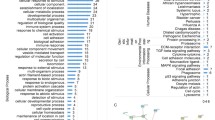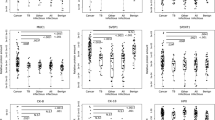Abstract
The focus of this study was to detect novel sera biomarkers for smear-positive and smear-negative pulmonary tuberculosis and to establish respective diagnostic models using the surface-enhanced laser desorption ionization time-of-flight mass spectrometry (SELDI-TOF MS) technique. A total of 155 sera samples from smear-positive pulmonary tuberculosis (SPPTB) and smear-negative pulmonary tuberculosis (SNPTB) patients and non-tuberculosis (non-TB) controls were analyzed with SELDI-TOF MS. The study was divided into a preliminary training set and a blinded testing set. A classification tree of spectra derived from 31 SPPTB patients, 22 SNPTB patients, and 42 non-TB controls were used to develop an optimal classification tree that discriminated them respectively in the training set. Then, the validity of the classification tree was challenged with another independent blinded testing set, which included 20 SPPTB patients, 14 SNPTB patients, and 26 non-TB controls. SNPTB patients and non-TB controls also were analyzed alone using the same method. The optimal decision tree model with a panel of nine biomarkers with mass:charge ratios (m/z) of 4821.45, 3443.22, 9284.93, 4473.86, 4702.84, 3443.22, 5343.26, 3398.27, and 3193.61 determined in the training set could detect 93.55%, 95.46%, and 88.09% accuracy for classifying SPPTB patients, SNPTB patients, and non-TB controls specimens, respectively. Validation of an independent, blinded testing set gave an accuracy of 80.77% for controls, 75.00% for SPPTB, and 71.43% for SNPTB samples using the same classification tree. With the peaks displaying differences between SNPTB patients and non-TB controls, a simplified dendrogram (m/z 4821.45, 4792.74) demonstrated classification efficacy of 85.94% (sensitivity 86.36% and specificity 85.71%) for distinguishing SNPTB patients from non-TB controls. The independent blinded testing set containing 14 SNPTB patients and 26 non-TB controls gained an accuracy of 81.59% (sensitivity 78.57% and specificity 84.62%) for diagnosing SNPTB. Special proteins/peptides may change in SPPTB and SNPTB patients and those changes may be used to distinguish them with the proper discriminant analytical method and to pursue and identify some involved proteins underlying the biological process of tuberculosis.





Similar content being viewed by others
References
World Health Organization. Global tuberculosis control 2009-epidemiology, strategy, financing. http://www.who.int/tb/publications/global_report/2009/en/index.html
Maher D, Chalet P, Spinaci S, Harries AD (1997) Treatment of tuberculosis: guidelines for national programmes, 2nd edn. WHO, Geneva
Soto A, Solari L, Agapito J, Acuna-Villaorduna C, Lambert ML, Gotuzzo E et al (2008) Development of a clinical scoring system for the diagnosis of smear-negative pulmonary tuberculosis. Braz J Infect Dis 12:128–132
Colebunders R, Bastian I (2000) A review of diagnosis and treatment of smear-negative pulmonary tuberculosis. Int J Tuberc Lung Dis 4:97–107
World Health Organization. Improving the diagnosis and treatment of smear-negative pulmonary and extrapulmonary tuberculosis among adults and adolescents. http://www.who.int/entity/tb/publications/2006/tbhiv_recommendations.pdf
Steingart KR, Dendukuri N, Henry M, Schiller I, Nahid P, Hopewell PC et al (2009) Performance of purified antigens for serodiagnosis of pulmonary tuberculosis: a meta-analysis. Clin Vaccine Immunol 16:260–276
Imaz MS, Schmelling MF, Kaempfer S, Spallek R, Singh M (2008) Serodiagnosis of tuberculosis: specific detection of free and complex-dissociated antibodies anti-mycobacterium tuberculosis recombinant antigens. Braz J Infect Dis 12:234–244
Garg SK, Tiwari RP, Tiwari D, Singh R, Malhotra D, Ramnani VK et al (2003) Diagnosis of tuberculosis: available technologies, limitations, and possibilities. J Clin Lab Anal 17:155–163
Weinberger SR, Dalmasso EA, Fung ET (2001) Current achievements using ProteinChip array technology [review]. Curr Opin Chem Biol 6:86–91
Merchant M, Weinberger SR (2000) Recent advancements in surface-enhanced laser desorption/ionization-time of flight-mass spectrometry [review]. Electrophoresis 21:1164–1167
Tang N, Tornatore P, Weinberger SR (2004) Current developments in SELDI affinity technology. Mass Spectrom Rev 23:34–44
Zhukov TA, Johanson RA, Cantor AB, Clark RA, Tockman MS (2003) Discovery of distinct protein profiles specific for lung tumors and pre-malignant lung lesions by SELDI mass spectrometry. Lung Cancer 40:267–279
Won Y, Song HJ, Kang TW, Kim JJ, Han BD, Lee S (2003) Pattern analysis of serum proteome distinguishes renal cell carcinoma from other urologic diseases and healthy persons. Proteomics 3:2310–2316
Lehrer S, Roboz J, Ding H, Zhao S, Diamond EJ, Holland JF et al (2003) Putative protein markers in the sera of men with prostatic neoplasms. BJU Int 92:223–225
Liotta LA, Ferrari M, Petricoin E (2003) Written in blood. Nature 425(6961):905
Petricoin EF, Belluco C, Araujo RP, Liotta LA (2006) The blood peptidome: a higher dimension of information content for cancer biomarker discovery. Nat Rev Cancer 6(12):961–967
Stone JH, Rajapakse VN, Hoffman GS, Specks U, Merkel PA, Spiera RF et al (2005) A serum proteomic approach to gauging the state of remission in Wegener’s granulomatosis. Arth Rheum 52:902–910
Wadsworth JT, Somers KD, Cazares LH, Malik G, Adam BL, Stack BC et al (2004) Serum protein profiles to identify head and neck cancer. Clin Cancer Res 10:1625–1632
Kang XX, Xu Y, Wu XY, Liang Y, Wang C, Guo J et al (2005) Proteomic fingerprints for potential application to early diagnosis of severe acute respiratory syndrome. Clin Chem 51:56–64
Papadopoulos MC, Abel PM, Agranoff D, Stich A, Tarelli E, Bell BA et al (2004) A novel and accurate diagnostic test for human African trypanosomiasis. Lancet 363(9418):1358–1363
Agranoff D, Fernandez-Reyes D, Papadopoulos MC, Rojas SA, Herbster M, Loosemore A et al (2006) Identification of diagnostic markers for tuberculosis by proteomic fingerprinting of serum. Lancet 368(9540):1012–1021
Seny D, Fillet M, Meuwis MA, Geurts P, Lutteri L, Ribbens C et al (2005) Discovery of new rheumatoid arthritis biomarkers using the Surface-Enhanced Laser Desorption/Ionization Time-of-Flight Mass Spectrometry ProteinChip approach. Arth Rheum 52(12):3801–3812
Kanmura S, Uto H, Kusumoto K, Ishida Y, Hasuike S, Nagata K et al (2007) Early diagnostic potential for hepatocellular carcinoma using the SELDI ProteinChip system. Hepatology 45:948–956
World Health Organization (2001) Revised international definitions in tuberculosis control. Int J Tuberc Lung Dis 5:213–215
Abebe F, Holm-Hansen C, Wiker HG, Bjune G (2007) Progress in serodiagnosis of Mycobacterium tuberculosis infection [review]. Scand J Immunol 66(2–3):176–191
Kanaya AM, Glidden DV, Chambers HF (2001) Identifying pulmonary tuberculosis in patients with negative sputum smear results. Chest 120:349–355
Demissie A, Wassie L, Abebe M, Aseffa A, Rook G, Zumla A et al (2006) VACSEL Study Group. The 6-kilodalton early secreted antigenic target-responsive, asymptomatic contacts of tuberculosis patients express elevated levels of interleukin-4 and reduced levels of gamma interferon. Infect Immun 74:2817–2822
Jamil B, Shahid F, Hasan Z, Nasir N, Razzaki T, Dawood G et al (2007) Interferon gamma/IL10 ratio defines the disease severity in pulmonary and extrapulmonary tuberculosis. Tuberculosis (Edinb) 87:279–287
Pathan AA, Wilkinson KA, Klenerman P, McShane H, Davidson RN, Pasvol G et al (2001) Direct ex vivo analysis of antigen-specific IFN-gamma-secreting CD4 T cells in Mycobacterium tuberculosis-infected individuals: associations with clinical disease state and effect of treatment. J Immunol 167:5217–5225
Vekemans J, Lienhardt C, Sillah JS, Wheeler JG, Lahai GP, Doherty MT et al (2001) Tuberculosis contacts but not patients have higher gamma interferon responses to ESAT-6 than do community controls in The Gambia. Infect Immun 69(10):6554–6557
Zhang M, Lin Y, Iyer DV, Gong J, Abrams JS, Barnes PF (1995) T-cell cytokine responses in human infection with Mycobacterium tuberculosis. Infect Immun 63:3231–3234
Meuleman W, Engwegen JY, Gast MC, Beijnen JH, Reinders MJ, Wessels LF (2008) Comparison of normalisation methods for surface-enhanced laser desorption and ionisation (SELDI) time-of-flight (TOF) mass spectrometry data. BMC Bioinformatics 9:88
Diamandis EP (2003) Point: proteomic patterns in biological fluids: do they represent the future of cancer diagnostics? Clin Chem 49:1272–1275
Baggerly KA, Morris JS, Coombes KR (2004) Reproducibility of SELDI-TOF protein patterns in serum: comparing datasets from different experiments. Bioinformatics 20:777–785
Ransohoff DF (2005) Lessons from controversy: ovarian cancer screening and serum proteomics. J Natl Cancer Inst 97:315–319
Acknowledgments
This study was supported by Grants #30425007, 30370627, 30670921 from National Natural Science Foundation of China and 00-722 and 06-834 from China Medical Board of New York to Dr. Fuqiang Wen.
Author information
Authors and Affiliations
Corresponding author
Electronic supplementary material
Below is the link to the electronic supplementary material.
Rights and permissions
About this article
Cite this article
Liu, Q., Chen, X., Hu, C. et al. Serum Protein Profiling of Smear-Positive and Smear-Negative Pulmonary Tuberculosis Using SELDI-TOF Mass Spectrometry. Lung 188, 15–23 (2010). https://doi.org/10.1007/s00408-009-9199-6
Received:
Accepted:
Published:
Issue Date:
DOI: https://doi.org/10.1007/s00408-009-9199-6




